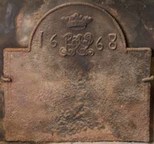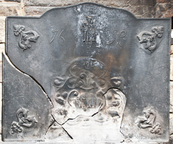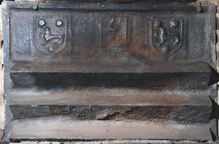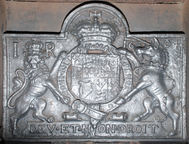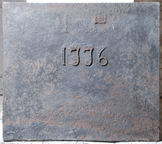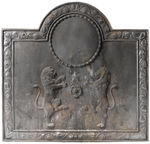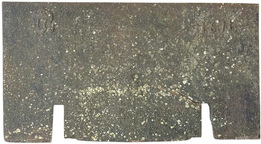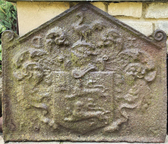-
1225
Description: Arched rectangular shape; twisted rope edging (top and sides); in arch, marquess's coronet above a monogram with date split either side.
Notes: The elaborate monogram has not been deciphered, but the fireback does not appear to be related to the Talbot family who owned Lacock throughout the 17th century.
Inscription: 16 [undeciphered monogram] 68
- Decoration tags:
- rectangular with round arch (shape)
- rope (edging)
- whole carved pattern
- individual numbers
- heraldic
- monogram
- text
Manufactured: in 1668 in England.
Current location: Lackock Abbey, Lacock, Wiltshire, England.
Museum number: 996713 (part of the National Trust museum group)
- Attached to series:
- Miscellaneous pattern firebacks
-
1307
Description: Rectangular shape with a flattened arch; astragal edging; top centre, stamp depicting a man and a woman in medieval dress, with inscribed date split to each side; in each corner and angled towards the corner, a triangular stamp formed of two mirrored sea serpents, their tails looped through a band, which also supports a flower rising from the serpents mouths; bottom centre, the weak impression of gadrooned vase fireback.
Notes: A bespoke fireback incorporating pseudo-antique elements, a spurious date inscribed by hand with a, probably deliberate, error in the orientation of the number 9. The 'medieval' couple and the corner stamps have yet to be identified. The impressed fireback is of the mid-17th century of the type illustrated as no. 1189.
Inscription: 16 59 [9 reversed]
- Decoration tags:
- rectangular with flattened arch (shape)
- astragal (edging)
- carved stamps
- composite
- individual numbers
Manufactured: in the late-19th to early-20th century in England.
Current location: Lindridge Place, Lamberhurst Quarter, Lamberhurst, Kent, England.
- Attached to series:
- Composite firebacks
-
359
Description: Rectangular; double fillet moulded edging; top centre, shield-shaped block with a rectangle containing the crest of the Fowles - an Arm in armour holding a Battle axe issuant from a Ducal Coronet, above the initials, WF; top left and right, two shields of the arms of the Fowle family - (Gules) a lion passant guardant between three roses (Or); across the lower half of the fireback are three solid triangular prisms of iron.
Notes: The stamps relate to William Fowle (1568-1634), ironmaster of Riverhall furnace. The stamps also appear on grave slabs in Wadhurst and Frant churches and on an unprovenanced graveslab in Maidstone Museum. The iron prisms were included, perhaps, to retain heat and to prevent the fireback from cracking.
Inscription: WF
Arms: William Fowle, of Frant and Wadhurst
- Decoration tags:
- rectangular (shape)
- fillet (edging)
- carved stamps
- heraldic
- armorial
- text
Manufactured: in the early-17th century probably at Riverhall Furnace, Wadhurst in the Weald area of England.
Current location: in private hands, Lamberhurst, Kent, England.
- Attached to series:
- Fowle series
-
360
Description: Arched rectangular shape; ovolo edging; Stuart royal arms of England (quarterly, 1st and 4th, France and England, 2nd Scotland and 3rd Ireland) with garter, crown, motto and supporters; initials either side of lion’s head; date either side of unicorn’s head.
Notes: The slightly awkward positioning of the date suggests it was added later. Copies were advertised in the Carron Company's catalogue.
Copies of this fireback are known.
Inscription: I R [Iacobus Rex] 16 04 / DEV ET MON DROIT
Arms: English Stuart royal - James I
- Decoration tags:
- rectangular with round arch (shape)
- cavetto (edging)
- whole carved pattern
- individual numbers
- armorial
- royal
- text
Manufactured: in 1604 possibly in the Weald area of England.
Current location: Scotney Castle, Lamberhurst, Kent, England.
Museum number: 791456 (part of the National Trust museum group)
- Attached to series:
- Jacobean royal armorial firebacks
- Stuart royal armorial firebacks
-
361
Description: Quasi-rectangular; twisted rope edging on top and sides; cavetto-moulded-edged rectangle top centre, enclosing date between initials; 17 shields of Ayloffe impaling Sulyard in three rows (5-6-6); Ayloffe: sable, a lion rampant Or, collared gules, between three crosses formy of the second; Sulyard: argent, a chevron gules between three pheons inverted sable.
Notes: William Ayloffe (c1535-1584) of Bretons, Hornchurch, Essex, Justice of the Court of Queen’s Bench, married (c1560) Jane, dau. of Sir Eustace Sulyard, of Runwell, Essex. The initials 'CT' are likely to be those of Charles Tyler, a founder whose working life and that of his family have strong parallels with the occurrence of these firebacks.
Inscription: C.1.6 2.0.T
Arms: Ayloffe impaling Sulyard (William Ayloffe of Bretons, Hornchurch)
- Decoration tags:
- rectangular (shape)
- rope (edging)
- carved stamps
- individual letters
- individual numbers
- armorial
- text
Manufactured: in 1620 possibly at Hawkhurst Furnace in the Weald area of England.
Current location: Scotney Castle, Lamberhurst, Kent, England.
Museum number: 791898 (part of the National Trust museum group)
- Attached to series:
- Ayloffe series
- Personal armorial firebacks
-
362
Description: Rectangle; no edging; date just above centre; initials above date.
Notes: The disparity between the quality of the stamping of the date and initials may be because the date has been stamped from a single block. There are stylistic similarities with the memorial plate to John and Ann Luck, dated 1771, in Wadhurst church porch, Sussex.
Inscription: I H / 1776
- Decoration tags:
- rectangular (shape)
- none (edging)
- carved stamps
- individual letters
- individual numbers
- text
Manufactured: in 1776 in the Weald area of England.
Current location: Scotney Castle, Lamberhurst, Kent, England.
Museum number: 791899 (part of the National Trust museum group)
- Attached to series:
- Date & initials firebacks
-
363
Description: Arched rectangular shaped, the arch linked to the rectangle by cavetto curves; cavetto edging ending in two opposed spirals at top; initials below spirals; date below initials; otherwise plain.
Notes: Probably cast from a carved, edged board, with the initials and date added separately.
Inscription: I or F H / 1698
- Decoration tags:
- rectangular with round arch (shape)
- carved stamps
- individual letters
- individual numbers
- text
Manufactured: in 1698 in the Weald area of England.
Current location: Scotney Castle, Lamberhurst, Kent, England.
Museum number: 791911 (part of the National Trust museum group)
- Attached to series:
- Small arch series
-
365
Description: Arched rectangular shape; astragal edging with parallel astragal enclosing a border of undulating convolvulus vine, leaves and flowers; bead and disc circle in arch, above a pair of lions rampant facing each other, between which are a five-pointed star above a rose.
Notes: A fireback in a retro-Regency style. Sotheby's auction, 27 Oct 2010, lot 209 (£2,500)
Copies of this fireback are known.
- Decoration tags:
- rectangular with round arch (shape)
- astragal (edging)
- whole carved pattern
- heraldic
- animals
Manufactured: in the late-19th to early-20th century in England.
Current location: in private hands, Lambourn, Berkshire, England.
- Attached to series:
- Miscellaneous pattern firebacks
-
1309
Description: Rectangular shape; no edging; top left, inverted 'renaissance' shield with the initials M above IE; top right, date 1671 in unseriffed numerals.
Notes: The shield with initials has not been noted on another fireback. The slots in the fireback are to accommodate andirons or firedogs.
Inscription: IME [triad] 1671
- Decoration tags:
- rectangular (shape)
- none (edging)
- carved stamps
- individual numbers
- text
Manufactured: in 1671 in England.
Current location: Lay's Auctioneers, Alverton Road, Penzance, Cornwall, England.
- Attached to series:
- Date & initials firebacks
- Andiron slot firebacks
-
1302
Description: Triangular arched shape; double fillet edging with scrolls above the top corners; in front of mantling, a shield bearing two lions passant guardant with an indistinct canton; above it a helm and crest of a probable ostrich; initials, the D reversed, to left and right of upper mantling.
Notes: The arms have not been identified
Inscription: D T
Arms: Not known
- Decoration tags:
- triangular arched (shape)
- double fillet (edging)
- whole carved pattern
- individual letters
- heraldic
- armorial
- text
Manufactured: in the 17th century in England.
Current location: Francis Barber Architectural Salvage, Kelmscott, Gloucestershire, England.
- Attached to series:
- Personal armorial firebacks
- Loop edged firebacks
